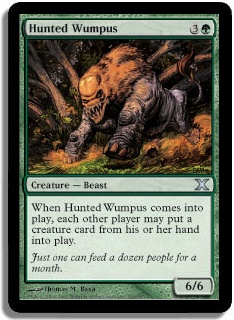
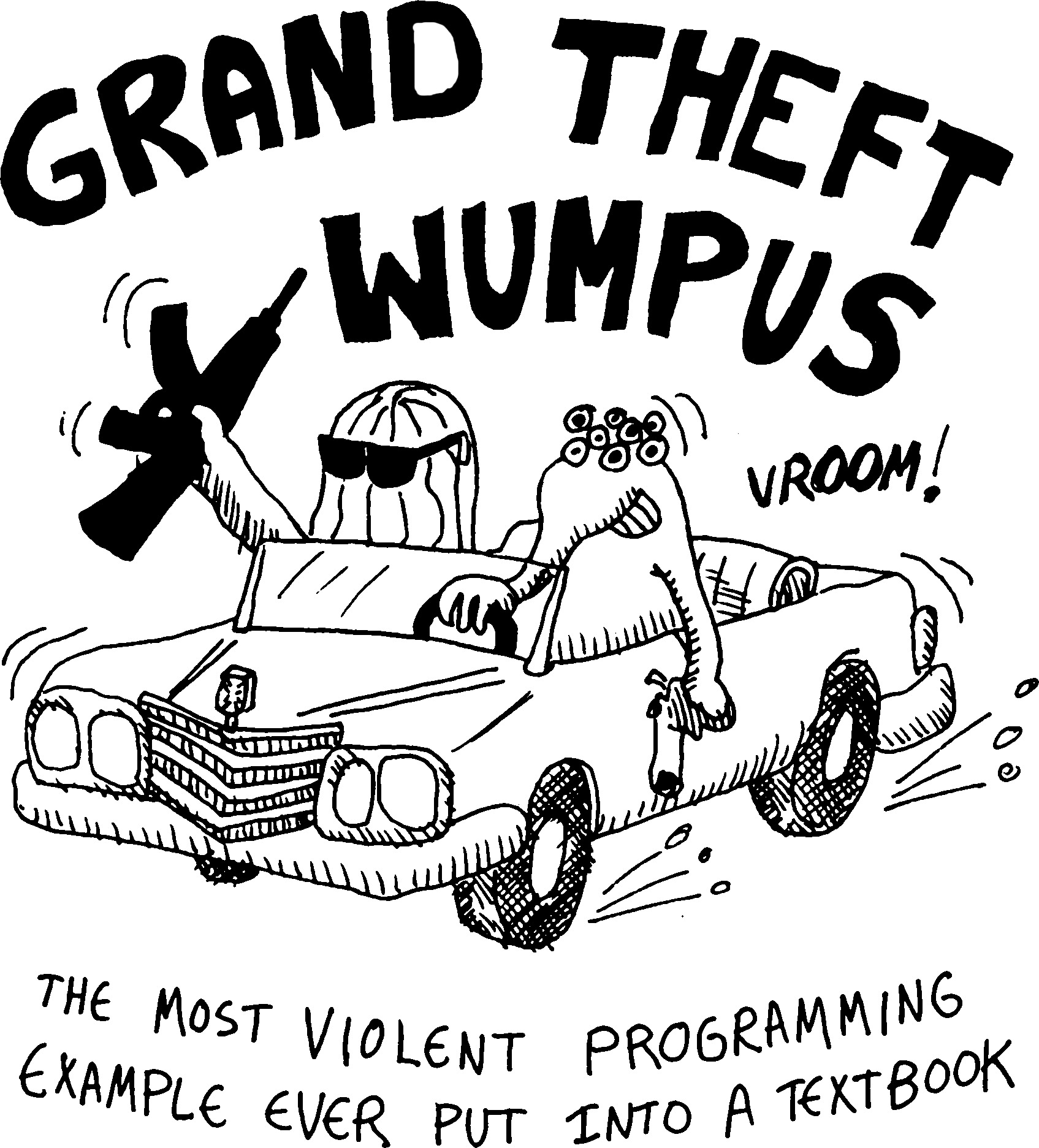
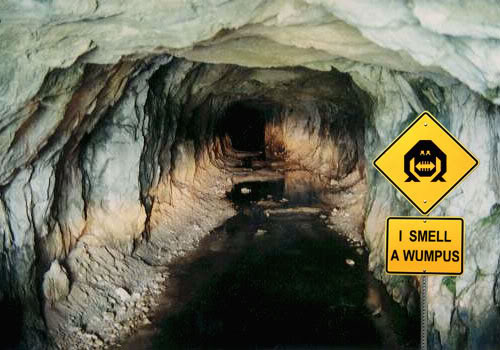
Time to infer my next move,
Find gold, and escape.



I smell a wumpus,
Time to infer my next move,
Find gold, and escape.
A total of 32 points can be earned over the course of this project, but only 24 points are needed to get full credit; any points over (8 more possible) will count as extra credit. (There is no specific part of the project that is extra credit; complete everything you can!)
In this project, you will build a propositional logic (PL) agent capable of solving a variant of the Hunt The Wumpus game. This will include constructing the agent's knowledge base and implementing simple search routines the agent uses for planning.
The code for this project consists of several Python files, some of which you will need to read and understand in order to complete the assignment, and some of which you can mostly ignore. All of the code is provided in the GitHub Classroom release repository.
NOTE: The abreviation AIMA used below refers to the Stuart Russell and Peter Norvig's book Artificial Intelligence: A Modern Approach, 4rd Edition, as well as the associated python code available from their AIMA GitHub repository. (However, all files needed for Project 3 are included in the GitHub Classroom release repository; do not replace the files here with the AIMA files as in two cases I have slightly modified the AIMA code).
wumpus_kb.py |
Contains code to generate the wumpus knowledge base. You need to fill in most of these functions! (most of these functions are "axiom generators", which will be described in more detail below). |
wumpus_planners.py |
Contains code to perform plan_route and
plan_shot. You need to fill in code to implement
the PlanRouteProblem and
PlanShotProblem.
See
search.py
for Problem parent class and examples. |
wumpus.py |
The main file to execute the Hunt The Wumpus game. Contains
code for generating WumpusWorldScenarios that combine
a WumpusEnvironment and agent (either
Explorer or HybridWumpusAgent) to play
the game. Includes agent programs to drive game play manually
(with and without a knowledge base). Also includes
__main__ command-line interface. |
wumpus_environment.py |
Implements main classes of the wumpus domain. The
Explorer agent is a simple wumpus hunter agent that
does not have a knowledge base. The WumpusEnvironment
implements the physics and game play of the Hunt The Wumpus
game. |
wumpus_agent.py |
Defines the HybridWumpusAgent (extends
Explorer). This agent includes a knowledge base. The
agent_program implements a hierarchy of reflexes that
are executed depending on the percepts and knowledge state. This
includes calls to plan_route and plan_shot
that you will implement in
wumpus_planners.py.
|
logic.py |
AIMA code implementing propositional (PL) and first-order (FOL) logic language components and various inference algorithms. You will want to look at the relevant PL implementation. NOTE: I have modified this file slightly from the current AIMA release. |
search.py |
AIMA code setting up basic search facilities; includes
Problem class that you will implement in
wumpus_planners.py
for plan_route and plan_shot.
NOTE: I have modified this file slightly from the current
AIMA release. |
wumpus_kb_axiom_print.py |
A helper script that calls each of the KB axiom generator functions with example arguments. This can be used to help in debugging and examining the current state of your KB axiom generator development. Note that this does not test your KB for correctness, it just provides a helpful shortcut for quickly generating examples using your axiom generator implementations. |
wumpus_planners_test.py |
A helper script that calls your current implementation of Plan Route Problem and Plan Shot Problem in a specific scenario (for each) to help with debugging your route and shot planning implementations. |
minisat.py |
Implements the interface to MiniSat, including translating AIMA
PL clauses into
DIMACS
CNF, generating the DIMACS file read by MiniSat, using python's
sys interface to call MiniSat, and reading the MiniSat
results. |
agents.py |
AIMA code for the generic Agent and Environment framework. NOTE: I have modified this file slightly from the current AIMA release. |
utils.py |
AIMA code providing utilities used by other AIMA modules. NOTE: I have modified this file slightly from the current AIMA release. |
Files to Edit and Submit: You will fill in portions of
wumpus_kb.py
and
wumpus_planners.py
during the assignment.
Here are the directions for submitting.
Evaluation: Your code will be autograded for technical correctness. Please do not change the names of any provided functions or classes within the code, or you will wreak havoc on the autograder. However, the correctness of your implementation -- not the autograder's output -- will be the final judge of your score. If necessary, we will review and grade assignments individually to ensure that you receive due credit for your work.
Academic Dishonesty: We will be checking your code against other submissions in the class for logical redundancy. If you copy someone else's code and submit it with minor changes, we will know. These cheat detectors are quite hard to fool, so please don't try. We trust you all to submit your own work only; please don't let us down. If you do, we will pursue the strongest consequences available to us.
Getting Help: You are not alone! If you find yourself stuck on something, contact us for help. If you can't make our office hours, let us know and we will schedule a meeting time. We want these projects to be rewarding and instructional, not frustrating and demoralizing. But, we don't know when or how to help unless you ask. One more piece of advice: if you don't know what a variable does or what kind of values it takes, print it out.
In the discussion and comments/docs in the code I freely switch between referring to the agent knowledge base, KB, kb and agent.kb. These are all the same thing: the collective facilities for generating and storing propositional logic sentences.
I sometimes abbreviate propositional logic as PL.
PL sentences expressed in full propositional logic are
sentences that may include all of the standard PL connectives:
And/Conjunction ('&'),
Or/Disjunction ('|'), Not/Negation
('~'), Conditional ('>>'),
and Biconditional ('<=>') (see
logic.py
for full details about the
PL python implementation). In the context of providing full PL
sentences to the KB as rules for updating the agent's knowledge state,
I will refer to these sentences as axioms.
When PL sentences are added to the KB, they are immediately converted to conjunctive normal form, CNF. This CNF representation is stored in the KB as a list of the individual disjunctive clauses (the list is treated as an implicit conjunction of its member clauses), and I will refer to the clauses in the list collectively as the KB clauses.
This project relies on the light weight, open source, cross platform SAT solver MiniSat (http://minisat.se). There are a variety of ways to obtain MiniSat; here are methods for the popular three platforms:
$ brew install minisat$ port install minisatminisat.py, line 183: Replace
COMMAND = 'minisat %s %s > /dev/null'with
COMMAND = 'minisat %s %s > ' + os.devnullor alternatively:
COMMAND = 'minisat %s %s > NUL'
$ sudo apt-get install minisatThis setup has been tested. If you want to develop on your windows machine, but run the autograder in the virtualbox, you just need to install the extension pack
After installing MiniSat and getting the Project 3 release from GitHub Classroom, you can then test the connection to MiniSat by executing the following from the command-line:
python wumpus.py -t
The three simple tests should pass. If they do not, or you get unexpected behavior, please contact us for help.
Having verified that the connection to MiniSat works, the next step is to familiarize yourself with the Hunt The Wumpus game. Execute the following at the command-line to to play the game:
python wumpus.py
This launches the interactive command-line interface to the game,
running in "Manual" mode: you control the wumpus hunting agent.
Entering 'env' at any point will display an ascii-art
representation of the current Wumpus enviroment state. For example, when
executed in the first time tick, you will see:
Scores: <Explorer>=0
0 1 2 3 4 5 time_step=0
|---|---|---|---|---|---|
| # | # | # | # | # | # | 5
|---|---|---|---|---|---|
| # | | | | | # | 4
|---|---|---|---|---|---|
| # | W | G | P | | # | 3
|---|---|---|---|---|---|
| # | | | | | # | 2
|---|---|---|---|---|---|
| # | ^ | | P | | # | 1
|---|---|---|---|---|---|
| # | # | # | # | # | # | 0
|---|---|---|---|---|---|
At the top, the current score of the Wumpus hunting agent (in the
default manual mode, represented as an <Explorer>) is displayed.
The x grid (horizontal) coordinates of the Wumpus environment are
displayed across the row above the grid, and the y grid (vertical)
coordinates are displayed down the right-side of the grid. Each grid
cell represents a wumpus cave room. '#' represents a wall, and 'W', 'P',
and 'G' represent the Wumpus, a Pit, and the Gold, respectively. The
position of the wumpus hunter agent is represented by one of '^',
'>', 'v', and '<', each of which show
the direction (heading) the hunter agent is currently facing. We will
also refer to the agent heading direction by the cardinal directions:
'^' is North, '>' is East, 'v' is South, and
'<' is West. At the start, as depicted in the above
environment display, the agent is in location (1,1) and facing North.
Enter
'?' at any time to see a complete list of available
commands.
The goal of the game is to achieve the highest score. Each move
costs one point, shooting the arrow (irrespective of whether it kills
the Wumpus) costs 10 points, and leaving the caves (accomplished by
executing 'Climb' in the same location that the hunter
agent started in (the cave 'entrance') with the Gold (i.e.,
having previously successfuly 'Grab'bed the Gold) earns
1000 points. Dying, by entering a square with the Wumpus or a Pit,
costs 1000 points.
At each time step, the current percepts are represented by a list of the percept propositions; '~' represents that the proposition is (currently) False. For example, at time 0 (indicated in the brackets on the left) the percepts for the environment depicted above are:
[0] You perceive: ['~Stench', '~Breeze', '~Glitter', '~Bump','~Scream']
Play several games and see how the Wumpus environment state
determines the percepts. Try dying by moving into the Wumpus square
or a Pit (when you die, the game ends; simply relaunch to play again!).
Shoot the Wumpus: you must execute 'Shoot'
while facing the Wumpus; when successful, the Wumpus will die and the
following time step you will perceive the 'Scream'; also
note that the Wumpus is no longr represented by 'W', instead replaced
by an 'X'. It is now safe to move into the Wumpus square. Also solve
the game by moving to the Gold, executing 'Grab', and
move back to the exit/entrance and execute 'Climb'.
You can load different Wumpus environment layouts by specifying
either the name of an existing layout in the
wumpus/layouts/
directory (currently there are
only two provided), or by specifying the path to a layout, using this
command-line option:
python wumpus.py -l wumpus_4x4_book
(You can optionally specify the layout extension '.lay'.) The format of a layout specification file is very simple; here's the layout for the environment displayed above:
.,.,.,. W,G,P,. .,.,.,. A,.,P,.
The file format specifies the Wumpus environment grid as a series of comma-separated wumpus-room specifications, with each row representing a row of rooms in the Wumpus environment. '.' represents an empty wumpus room, 'W' places a Wumpus (the knowledge base you will create below can only accommodate presence of exactly 1 Wumpus, no more or less, but in the manual game you can have multiple Wumpi), 'P' places a Pit, 'G' places the Gold (again, the KB will only support Grabbing 1 Gold), and 'A' is the location of the Wumpus hunting Agent (The Agent's heading is specified separately in code; North, or '^', is the default). You can also add Walls, represented by '#'. By default, the specified layout will be automatically surrounded by Walls when the Wumpus environment is constructed.
Take a look at the code comments and examples in
wumpus.py
to see how to construct
a WumpusWorldScenario from a layout file or by specifying directly in
code by constructing objects and assigning them to Wumpus environment
locations.
There are two main classes that together make a working version of
the Hunt the Wumpus game: the WumpusEnvironment and an
instance of an agent are combined in a
WumpusWorldScenario, defined in
wumpus.py.
WumpusEnvironment, defined in
wumpus_environment.py,
represents the Wumpus cave environment, the position and state of all
objects, and enforces the rules of the game (the game 'physics'), such
as the effects of agent actions. The step() method
advances the game one time step and includes calling the Wumpus hunter
agent's agent_program.Explorer, also defined in
wumpus_environment.py,
provides a minimal hunter agent skeleton, while the
HybridWumpusAgent, defined in
wumpus_agent.py,
is a full agent implementation and includes a knowledge base and set
of reflexes sufficient to solve any Hunt the Wumpus game (once you
provide some code).The main action of a wumpus hunter agent happens in its
agent_program. There are three different
agent_programs provided:
with_manual_program (in
wumpus.py) takes an agent as input
and replaces its agent_program with a "manual"
agent_program in which the agent waits for commands
from the command-line at each step. This is the agent that is run
when launching the game from the command-line with (with or without
the '-l' layout file option):
python wumpus.pyThis version is most useful for playing the game and verifying you understand the "physics" of the Wumpus environment (i.e., the effects of actions on states of the world and subsequent percepts).
with_manual_kb_program (also in
wumpus.py) works similar to
with_manual_program except the agent also creates a
knowledge base and the agent_program updates the
knowledge base with new percepts and the action selected (by the
human user) at each step. The user can also issue any relevant
query about propositions in the knowledge base. This option is most
useful for developing and debugging the axioms you provide for
initializing and updating the knowledge-base. You will implement these
axioms in the axiom generators in wumpus_kb.py. Until these
axiom generators are implemented, your KB will not be fully functional.
The with_manual_kb_program agent program can be run by
executing the following from the command-line (inside the
wumpus/ directory):
python wumpus.py -k(You can also combine this with the '
-l' option to load
a specific layout.) Once launched, enter '?' to get the
list of commands and complete list of available knowledge base queries.
HybridWumpusAgent (HWA) class is defined in
wumpus_agent.py
(it is a
subclass of the Explorer). The HWA defines an
agent_program that implements the Wumpus agent as
specified in Figure 7.20, page 242 of AIMA 4th Edition.
Once you have correctly implemented the knowledge base
axiom generators (in
wumpus_kb.py), and the
PlanRouteProblem and PlanShotProblem methods (all
in
wumpus_planners.py), the
HWA agent_program will be able to solve any (solvable)
instance of the Hunt The Wumpus game. The HWA and its
agent_program can be run from the command-line (inside
the wumpus/ directory) with:
python wumpus.py -y(Again, you can also combine this with the '
-l' option;
however, the '-y' option will override the '-k'
option, if included). When run, the HWA agent_program
will select all actions, so there is nothing for the human user to do
but watch. As with the above options, the output to screen is
intentionally very verbose so that you can follow along with each step
in the execution.
layouts/):
HWA_lay_book_run.txt
and
HWA_lay_2_run.txt.
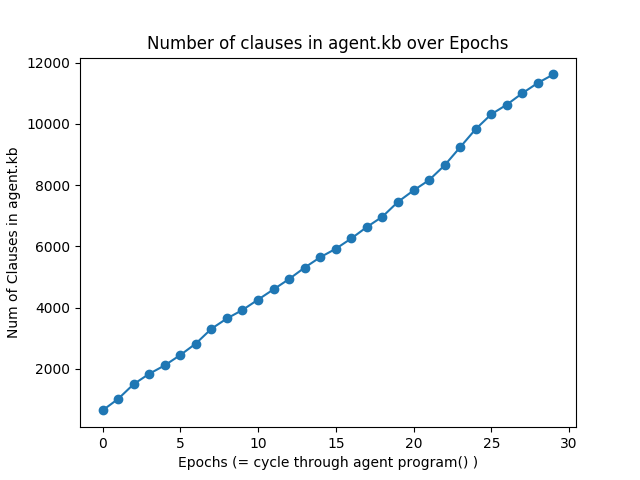
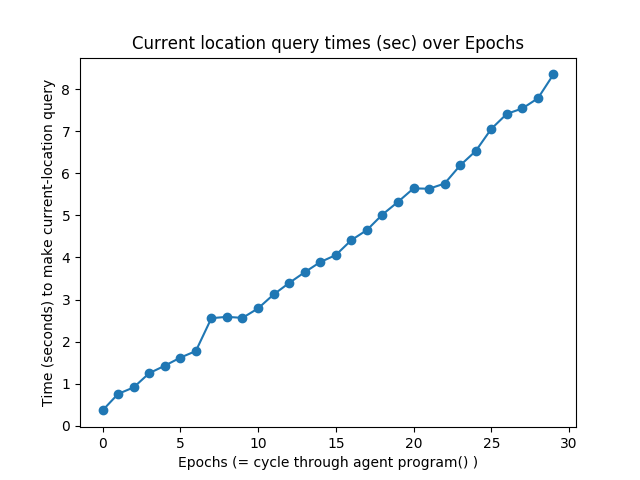
NOTE: While you can construct layout sepcifications (either in layout files or in code) in any dimensions, it is recommend that you follow these general constraints (mainly due to working with the knowledge base; for general manual play without a KB, any size is fine):
As the knowledge base and agent planner(s) developer, you have
several choices as to how to proceed with development. The manual
command-line interfaces to the wumpus game, defined above and
implemented in
wumpus.py,
were designed to be a way by which you can directly observe the impact
of code changes on knowledge base inference and agent behavior.
However, you may find some or all development easier by incrementally
instantiating and testing parts of the code; in this case, start with
the WumpusWorldScenario to see how the main pieces are
put together.
The two agent programs you will be working with (found either in
with_manual_kb_program in
wumpus.py
or the
HybridWumpusAgent (HWA) class defined in
wumpus_agent.py)
make use
of the PropKB_SAT knowledge base. This is defined in
wumpus_agent.py
and
is a subclass the PropKB class defined in
logic.py.
As you'll see, these
are actually quite simple, implementing the tell()
method to add new sentences to the knowledge base, and the
ask() method to query the knowledge base
(ask() is an interface MiniSat). Assertions made to the
knowledge base (often starting as PL syntax expressed in a string)
are stored in the clauses field of the KB, and that is
just a python list! (Robust implementations of propositional KBs
have much more sophisticated storage). Representation of the
assertions (sentences) themselves are built on top of the AIMA
implementation of propositional logic. As you will be implementing
axiom generators, it is important you understand how propositional
sentences, initially expressed in strings, are turned into the
underlying propositional logic representations. Take a look in
logic.py. In particular,
the following excerpt from the python prompt demonstrates some of the
basic functionality.
In [1]: import logic # Express a propositional logic sentence in a string In [2]: a = '(A & B) >> ( ~(C | D) <=> E )' # Create an expression object representation of the propositional logic # sentence in the string a In [3]: e = logic.expr(a) # Display the expression (this matches the original string representation) In [4]: e Out[4]: ((A & B) >> (~(C | D) <=> E)) # Convert the PL expression to conjunctive normal form (CNF) In [5]: c = logic.to_cnf(e) # Display the CNF In [6]: c Out[6]: ((~C | ~E | ~A | ~B) & (~D | ~E | ~A | ~B) & (E | C | D | ~A | ~B)) # Get the list of conjuncted clauses (used in the internal KB clause store) In [7]: logic.conjuncts(c) Out[7]: [(~C | ~E | ~A | ~B), (~D | ~E | ~A | ~B), (E | C | D | ~A | ~B)]
On line 2, I express a propositional sentence in a string, in the
syntax of the AIMA propositional language. See the Expr
class in
logic.py. The
function expr() parses that string and builds an
Expr object. The Expr object is designed to have a
"pretty" python representation, an example of which is on line 4 above
(this is accomplished by the definition of the __repr__()
method in Expr; see this
explanation). But keep in mind that this is an object! It has
two main fields: the expression operator, op, and a list of
arguments to the operator, args. Since the variable
e currently references the Expr, we can inspect the
op and args as follows:
In [10]: e.op Out[10]: '>>' In [11]: e.args Out[11]: [(A & B), (~(C | D) <=> E)]
This shows that the Expr e refers to has as its
operator the conditional symbol (>>), and its args have two entries, the
first being the antecedent to the conditional, in this case A
& B, and the second is is the consequent, ~(C | D)
<=> E. Each of these are also Exprs, with the first having the
conjunction operator, '&', with two args
A and B. In this way, our original Expr
referred to by e is actually the root of an Expr tree,
allowing for representation of arbitrarily complex sentences.
Be sure to look at the docs for Expr and
expr() in
logic.py to understand how the PL
syntax will be parsed from a string, in particular the note in the
docs of expr() about operator precedence: expr('P &
Q ==> R & S') will be parsed as ((P & (Q >> R)) &
S), which may not be what you intended! To get the expected
operator precedence enforced (i.e., & with higher
precedence than ==>), you must use expr('(P & Q)
==> (R & S)'). In general, it is best to use parentheses to
enforce the precedence you intend!
Moving on with the original example, on line 5 I convert the full
PL sentence into conjunctive normal form using the
to_cnf() function; line 6 shows the result. This is still
an Expr object; also it is completely logically
equivalent to the previous form expressed on lines 2 and 4. Whenever
an Expr is tell()ed to the KB, the Expr will be converted
to CNF. Then the conjuncts of the CNF will be extracted so that what
is stored in the clauses store of the KB is a list of the
individual clauses of the CNF. This is demonstrated on line 7.
Finally, a note about the use of MiniSat. MiniSat is a SAT solver,
meaning that it searches for a satisfying assignment of truth values to
the proposition variables in a set of
CNF clauses -- that is, that makes the entire set of sentences True.
The SAT sovler returns True if such an assignment is found (and in
MiniSat's case, it also returns the satisfying assignment), or False
if no assignment is found. This is a good building block but not by
itself sufficient for propositional inference. In our case, we will
not be doing full proposition inference, but instead asking whether
individual propositions are entailed (True) or not (False) by the KB,
or whether their truth cannot be determined (unknown). In order to determine
which of these three possible outcomes is the case, the
ask() method of PropKB_SAT makes two
calls to minisat, one which the query variable (the proposition variable
who's truth we're trying to determine) is assumed to be True, and one
where it is assume to be False, and in both cases minisat determines
whether that assertion conjuncted with all of the clauses in the KB is
satisfiable. If the clauses + query are satisfiable in both
cases, then that means the KB cannot determine whether the proposition
is True or False. On the other hand, if one call to minisat is
satisfiable, but the other not, then the proposition's truth is which
of the calls was satisfiable. In general you won't have to worry
about these details, but it is important to understand how this is
working!
OK, time to get to work! The first set of tasks is to fill in the
axiom generators for the knowledge base. For this part of the project
you will work in
wumpus_kb.py, adding your code
to all locations indicated by "### YOUR CODE HERE ###".
You will notice a pattern here: all of the methods you are
implementing start with "axiom_generator_..." in their name.
Section 7.7 of AIMA (4th Ed), starting on page 237, is a good guide for a number of the axioms you are required to implement. But beware, it is incomplete!
After the current percept sentence generator (which converts percept vectors into a sentence asserting percept propositions), there are two general classes of axiom generators you will construct: a set that generates axioms describing the initial state of knowledge, and axioms that represent changes over time (in particular, the successor-state axioms).
The provided helper script wumpus_kb_axiom_print.py
includes example calls for each of the axiom generators you will implements,
with example provided arguments. This can be used to help assess your
current progress in yoru axiom generator development. Note that this script
does not test the correctness of your axiom generators; for that you should
try out different inference steps while running the wumpus agent with the
-k (for manual) and -y (full automated agent) modes.
The assertions your generators will make will be built out of
propositions. The first section of
wumpus_kb.py defines every
proposition that will appear in the KB. Because it would be very easy
to add a malformed proposition symbol to the KB without knowing it, I
have provided a set of proposition string builder functions, one for
each type of proposition. Even though it is more verbose to use
function calls like percept_breeze_str(3) rather than
just 'Breeze3', you'll be better off, as the KB itself
won't tell you if you happened to have mistakenly asserted
'Breez3' (that's a misspelling!) -- the KB will happily
accept it and you'll be left to find your mistake through painful
debugging! However, the choice is entirely up to you -- nothing about
the grading will check whether you use these string-builders
You will be working a lot with strings in this part of the project. Here are general python string functions that I found useful while building my solution:
'a' + 'b' results
in 'ab'join method is very handy; the first string the
join being called on will be inserted between the listed strings
being joined (use an empty string to just concatenate the list of
strings):
''.join(['a','b','c']) results in
'abc''-'.join(['a','b','c']) results in 'a-b-c'format method is your friend: 'string
with {0}{1}'.format('stu', 'ff')'string
with stuff'Points will be awarded, pending correct implementation, as follows (for a total of 24 points):
axiom_generator_percept_sentence = 1 ptaxiom_generator_initial_location_assertions = 0.5 ptaxiom_generator_pits_and_breezes = 1 ptaxiom_generator_wumpus_and_stench = 1 ptaxiom_generator_at_least_one_wumpus = 1 ptaxiom_generator_at_most_one_wumpus = 1 ptaxiom_generator_only_in_one_location = 1 ptaxiom_generator_only_one_heading = 1 ptaxiom_generator_have_arrow_and_wumpus_alive = 0.5 ptaxiom_generator_location_OK = 1 ptaxiom_generator_breeze_percept_and_location_property = 1 ptaxiom_generator_stench_percept_and_location_property = 1 ptaxiom_generator_at_location_ssa = 4 ptsaxiom_generator_have_arrow_ssa = 1 ptaxiom_generator_wumpus_alive_ssa = 1 ptaxiom_generator_heading_{north,east,south,west}_ssa = 3 pts
(for the set)axiom_generator_heading_only_{north,east,south,west} = 2 pts
(for the set)axiom_generator_only_one_action_axioms = 2 ptsNOTE: While you are constructing the knowledge base
generators, the KB should always be satisfiable. If it ever becomes
unsat, then something you have added is leading to a contradiction!
That is always a problem. To check for satisfiability of the KB, call
the minisat() function in
wumpus_agent.py with just
the KB clauses, e.g., minisat(kb.clauses); when running
the wumpus.py with a KB (option -k) from the
command-line, you can enter the 'kbsat' command to do the
same thing. Note, however, that just because the KB is satsifiable
does not mean there are not other problems.
The second major task of Project 3 is to complete the
implementation of the route and shot planning for the Hybrid Wumpus
Agent. Your coding will take place in
wumpus_planners.py.
The docs for plan_route and plan_shot
outline the problem, but the code to be added will be in the
PlanRouteProblem and PlanShotProblem
classes, both of which extend the search Problem class
(defined in
search.py)
that serves as the interface to the AIMA search code.
The goal_test in both problems is initially set to
always return True, and both plan_route and
plan_shot will return empty action lists if finding a
solution fails. This allows you to run the full Hybrid Wumpus Agent
even before these planning facilities are implemented, but obviously
you'll be changing things.
Once implemented, both plan_route and
plan_shot will use the AIMA implementation of A*, which
is also defined in
search.py
(as astar_search()).
It is recommended that you implement PlanRouteProblem
first, as much of the solution there can be used in
PlanShotProblem. Remember, for the
PlanShotProblem, you only need to plan a path to the
closest location in which you will be facing the Wumpus.
As noted in plan_route and plan_shot, the
representation of a state is a triple representing the x, y
location and heading, of the agent. The heading is an integer of 0,
1, 2, or 3, representing North, West, South, and East, respectively.
Goals and allowed states, however, ignore heading, and thus are just
lists of x,y tuples. manhattan_distance_with_heading()
has been provided; as the name suggests, it computes the Manhattan
distance, but also adds in the cost of having to change the heading
(i.e., turn to the correct orientation) before following the Manhattan
path.
Correct implementation of each search problems is worth 4 points each, for a total of 8 points.
The provided script wumpus_planners_test.py will run your
current implementations PlanRouteProblem and
PlanShotProblem and can be used to help with debugging.